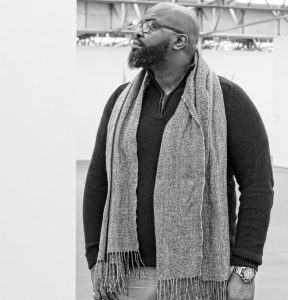In the video work, you hold the ornately decorated staff of your ancestors in your hands for the first time. How did the collaboration with the curator Andrea Scholz, the Mauritshuis and the exhibition team come about?
I was approached by the guest curators and creative directors Kel O’Neill and Eline Jongsma concerning the staff. I had been part of a project that they also participated in and that is how we met. As front-runners of that exhibition they wanted to create a story around the staff and that’s how we got to work together.
Can you tell us something about the significance of the staff and the ornate carvings?
The meaning of the staff is not entirely clear, but what is clear is that it is a representation of a culture that has deteriorated over time due to outside influence. The way the staff came into possession of the Ethnological Museum, through no fault of them, shows how people viewed my culture and my ancestors. They were seen as people in need of salvation, not fit to decide for themselves how their future should look like. Overlooking artisan skills, intelligence and their place in the world. The artist of the staff probably tried to depict the importance of females in our society and made an homage to them. What IS abundantly clear though, is that it represents a maroon woman of our tribe, because of the body markings. A lot of women in the past bore these markings as it was seen as a sign of beauty. We call them “koti, koti” which translates to “cuttings”
Your uncle is the traditional head of the Wanhatti region. What significance does the staff have for you, your family and your ancestors?
Simply put, it is a way to connect to the past. It is evidence of a time that not a lot of people know about, let alone remember. It is evidence that we were not always in this state, religious, political social etc. There is a trail here that connects to a different time, and it does not correlate with the stories that were told to us. It gives hope, that one day, we can make informed decisions concerning our identity and who we want to be.
Has the research and collaboration on the video had an impact on the relationship between the people of Suriname and the Ethnologisches Museum in Berlin? What happens now?
I do not think so, not a lot of people are aware of the staff, even though this information has not been kept hidden. I think that a re-introduction of this artifact and this subject matter should be established and then proceed forward.
What do you want for the future?
Simply put, collaboration and restoration. My dream is to set up a central hub, where looted, stolen, misplaced artifacts concerning maroon people of all places can be gathered and redistributed to their corresponding people and places of origin. In such a place we could come together and learn, study and learn from history. And that includes researches, museums, rightful owners, diaspora etc. I am not looking to point fingers and blame, I hope that in the appropriate cases, entities involved take their responsibility and help create a path forward. The past cannot be changed, we are not our ancestors, but we are their descendants, and that gives opportunities because now we have a different perspective.
